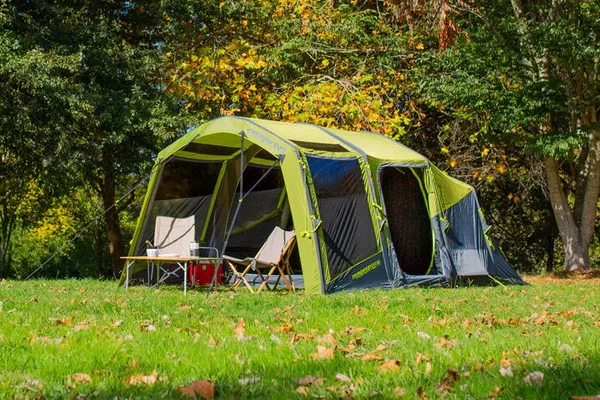Finding the right tent for your backpacking adventures is crucial. A good 3-person backpacking tent offers enough room for you and your companions while being lightweight and durable. Below, we explore the best options available, considering features like weight, space, weather resistance, and ease of setup.
Why Choose a 3-Person Tent?
A 3-person tent is ideal for small groups or couples who want extra space. These tents strike a balance between weight and comfort. They offer more room than a 2-person tent but are lighter than larger models.
The extra space allows for better storage of gear and movement. This makes it a favorite among backpackers who value comfort without compromising on portability.
Key Features to Look For
Before buying a tent, consider the following factors:
1. Weight
Since you’ll carry the tent during your trip, weight is a major factor. A good 3-person backpacking tent weighs around 4-6 pounds. Look for options with lightweight materials like aluminum poles and nylon fabric.
2. Interior Space
Ensure the tent provides adequate sleeping and gear space. A peak height of around 40 inches allows for comfortable sitting. Also, check the floor dimensions to confirm it fits three sleeping pads.
3. Durability
Backpacking can expose tents to rough conditions. Materials like ripstop nylon and durable zippers enhance longevity. A tent should withstand wear and tear from wind, rain, and rough ground.
4. Weather Resistance
A good tent protects against rain, wind, and bugs. Look for waterproof materials with a durable rainfly and sealed seams. Ventilation features like mesh panels are also essential for reducing condensation.
5. Ease of Setup
Backpacking tents should be quick and easy to pitch. Freestanding designs with color-coded poles simplify the process.
Top 3-Person Backpacking Tents
Here are some of the best 3-person backpacking tents based on performance, durability, and customer reviews:
1. Big Agnes Copper Spur HV UL3
The Big Agnes Copper Spur HV UL3 is a favorite among backpackers for its lightweight and spacious design.
- Weight: 3 lbs 14 oz
- Floor Area: 41 square feet
- Peak Height: 43 inches
- Features: Dual doors, two vestibules, and a freestanding design.
This tent is made from ultralight ripstop nylon, making it both durable and portable. Its roomy interior ensures comfort for three people. The tent also includes large vestibules for gear storage.
Pros:
- Lightweight and compact.
- Easy to set up.
- Great ventilation with mesh panels.
Cons:
- Expensive.
- Limited weather resistance in extreme conditions.
2. MSR Mutha Hubba NX
The MSR Mutha Hubba NX is known for its balance between weight and durability.
- Weight: 4 lbs 13 oz
- Floor Area: 39.5 square feet
- Peak Height: 44 inches
- Features: Unified hub-and-pole system for quick setup, Xtreme Shield waterproof coating.
This tent offers excellent protection against rain and wind. Its roomy interior and large vestibules make it ideal for longer trips.
Pros:
- Reliable in wet weather.
- Easy to pack.
- Durable construction.
Cons:
- Slightly heavier than some competitors.
- Pricey.
3. Nemo Dagger OSMO 3P
The Nemo Dagger OSMO 3P combines sustainability with top-notch performance.
- Weight: 4 lbs 5 oz
- Floor Area: 41.2 square feet
- Peak Height: 42 inches
- Features: 100% recycled OSMO fabric, spacious vestibules, and freestanding design.
This tent is eco-friendly, using sustainable materials without compromising quality. Its interior space and easy setup make it a solid choice for backpackers.
Pros:
- Eco-friendly materials.
- Excellent interior space.
- Lightweight for its size.
Cons:
- Limited availability in some regions.
- Slightly less durable than nylon alternatives.
Additional Recommendations
Kelty Late Start 3
This budget-friendly tent offers a reliable option for those on a tighter budget.
- Weight: 6 lbs 4 oz
- Floor Area: 40.6 square feet
- Peak Height: 43 inches
- Features: Simple design, durable poles, and good ventilation.
Pros:
- Affordable.
- Durable materials.
- Easy to set up.
Cons:
- Heavier than premium models.
- Basic features.
Tips for Choosing the Best Tent
1. Know Your Needs
Consider the typical weather, terrain, and duration of your trips. If you often backpack in rainy areas, prioritize waterproofing.
2. Test Setup
If possible, practice setting up the tent before your trip. This helps you understand how it works and saves time in the field.
3. Look for Compact Designs
Choose a tent that packs down small to save space in your backpack. Compression sacks can further reduce size.
4. Check Ventilation
Good ventilation prevents condensation inside the tent. Mesh panels and adjustable rainflies help maintain airflow.
5. Think About Gear Storage
Vestibules are essential for keeping gear dry and organized. Look for tents with multiple vestibules for better storage.
Maintaining Your Tent
Proper care extends the life of your tent:
Clean After Use: Shake out dirt and debris. Wipe down any stains with a damp cloth.
Dry Thoroughly: Ensure the tent is completely dry before storage to prevent mold.
Store Properly: Use a storage bag instead of a compression sack for long-term storage.
Repair Damage: Fix small tears or broken zippers promptly to avoid bigger problems later.
Conclusion
A 3-person backpacking tent is a versatile and practical option for outdoor enthusiasts. Tents like the Big Agnes Copper Spur HV UL3, MSR Mutha Hubba NX, and Nemo Dagger OSMO 3P offer excellent performance and features.
By considering factors like weight, space, and weather resistance, you can find the perfect tent for your adventures. With the right choice, you’ll enjoy comfortable and memorable trips in the great outdoors.
Related topics
- Best Travel Chair for Sports: A Comprehensive Guide
- The 5 Best Off-Road Camper Vans
- Top 4 Double Self-Inflating Mattresses 10cm


